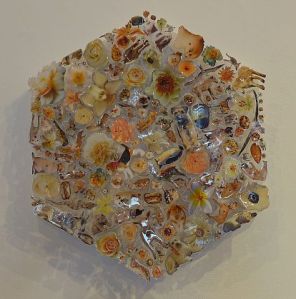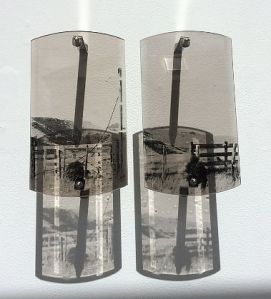Gallery visit last week to Bath Street Gallery in Parnell. It had a show on with works about collecting and liquid light photography that piqued my interest. The show’s title was Multiplicity and was by four recent Ilam graduates. The collection works by Alison Staniland was created through her own form off ordering & categorising. After collecting and cutting out multiple colourful images from books/magazines, of anything organic or natural. These images are then grouped according to colours and arrangements made into circles or hexagonal’s. Using entomological pins the images are pinned just like a scientific method used for butterflies or bugs. The pins were all placed in the centre of the image, which in some cases worked well with the image. I do wonder that using this method it may have been better to consider an off centre placement of the pin for some of the images or even use of more than 1 pin.
 Light Hexagon, 2014 entomology pins, resin pins, resin and magazine cutouts. 40 x 35 cm
Light Hexagon, 2014 entomology pins, resin pins, resin and magazine cutouts. 40 x 35 cm
The intrigue for me was the collecting aspect and then the personal criteria of categorising. There were aspects of these works that really resonated with me, such as the careful colour selection of each image and how the images were puzzled together to create the over all shapes. Upon personally experiencing the works I was left wondering about the deeper meaning. These works definitely had collector written all over them, with a scientific bend and approach. They also had a bit of Wunderkammer and early collector fascination to them, as in the early period of collecting, all matter of items were displayed together. No ‘real’ scientific ordering was present in those early days of the Cabinets of Curiosities.
The series of works using the liquid light by Bianca van Leeuwen thew up some interesting questions for me. As there were 4 groups displayed, of which 2 were a diptych, then 2 larger works of a grid using many. Each individual work was done on a rectangular shaped piece of glass that hada curved top and bottom and the sides had a bevelled edge. Some of the works had a smoky look to them.
 Banks peninsula
Banks peninsula
It was after speaking to the curator that this smoky appearance became clear. (the glass pieces were from a found lamp shade) This smoky look made the works have an old classic feel about them, which was in stark contrast to the hanging system used to display them (the hanging brackets were unfortunately a distraction for me, they felt like a row of braces) The biggest challenge, for me the viewer, was to try and visually isolate one image from the mass, while trying to find links between each, considering they were hung together in a large grid formation.
Researching her work I came across this image from this web page:http://eyecontactsite.com/2011/05/ilam-masters-show
 Conscripted reflections: Collective bearings. 2011 Found Objects, SEI Emulsion, steel and oil.
Conscripted reflections: Collective bearings. 2011 Found Objects, SEI Emulsion, steel and oil.
And have been left wondering if this original display method suited the work better. It not only placed the glass sheets back into their original format, but it also would have allowed for the viewer to see one image at a time. While still creating a link between the images through the mere fact that they were tied together in a circular pattern. These works did feel like a journey, a nostalgic journey through the country side, as few images contained buildings. All had hills, open spaces and some man made elements in them like power poles or roads. The 2 diptych works on the other hand felt easy to visually access & process. The images related to each other and the hanging system did not over power the delicate images.
One of the reasons for me to see this show was to see how glass photographic works can be displayed and how a collection of images can be arranged. Visiting this show was worth while to gather some display/arrangement ideas for my own practice. Vital aspects I gleaned from this are; the display methods used, shadow patterns through the glass, number of works to hang together, placement of pins and is a traditional framing system the best way? (Note to the readers of this entry: I by no means am an art critic and this blog is more a reflective blog for my study and my practice.)
